Given its location on the Outer Banks, Cape Hatteras National Seashore experiences high numbers of marine mammal strandings each year, this includes cetaceans (whales, dolphins, and porpoises), pinnipeds (seals), and rarely sirenians (manatees). An average number of stranded marine mammals (57) were documented during 2015. The majority of strandings occurred on Hatteras Island. Two military training events were reported in 2015 corresponding with 3 stranded animals.
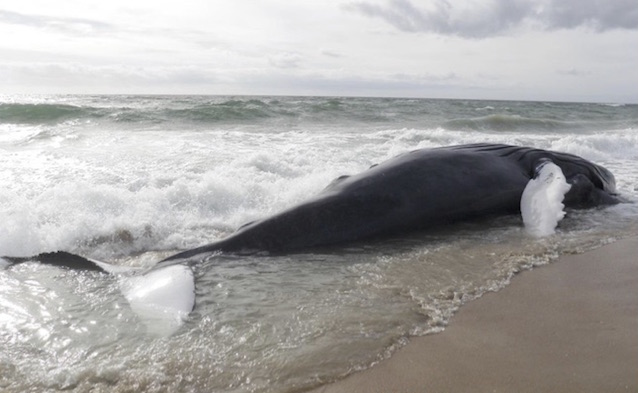
National Park Service
Introduction
The Outer Banks of North Carolina, known for history, hurricanes, and shipwrecks also happen to be a hotspot for marine mammal activity. Recorded strandings date back to 1884, so it can be argued that the Outer Banks has the longest running record of marine mammal strandings in the world. Thusly, CAHA is a melting pot of species diversity when it comes to marine mammal strandings – given its location on the Outer Banks. The seashore is comprised of barrier island chains that extend into the Atlantic Ocean and come in very close proximity to the continental shelf, and for this reason a large number of strandings occur within park boundaries. At any given time, a wide arrangement of marine mammals move-about and feed very close to CAHA beaches, influenced chiefly by the southern Gulf Stream and the northern Labrador Current colliding off our coast.
The seashore has encountered a vast diversity of stranded species as well as few common species that strand more frequently. This includes a resident bottlenose dolphin population that relies utterly on our coastal environment; long-living individuals can exceed ages of >50 years. One factor affecting this stranding species variation is water temperature. The surrounding water temperatures can vary considerably; warmer temps bringing southern species closer and colder temps bringing northern species closer to CAHA. Collectively, the large numbers of marine mammals are sometimes coupled with outside factors such as intense fishery actions, strong hurricanes and Nor’easters, active Military Training Exercises, or even zoonosis, leading to high stranding numbers of both live and dead animals.
Methods
National Park Service (NPS) technicians respond to live and dead marine mammals in CAHA by patrolling the beach regularly using 4x4 trucks or UTV’s and conducting walkthroughs on the Pamlico sound side of the islands during fall, winter, and spring. Also, technicians receive and respond-to many strandings reported by the general public. This also includes reports from the Outer Banks Marine Mammal Stranding Network (OBXMMSN), of which the NPS is also a member. The network is chiefly comprised of the National Park Service and the North Carolina Wildlife Resources Commission, and is governed by the NC State Stranding Coordinator based out of the University of North Carolina – Wilmington.
Collectively, there is potential for any member of the OBXMMSN to assist with any live or dead stranding and/or necropsy event. Given the condition of the animal (generally fresh dead or moderate decomposition), a necropsy will be conducted with the goal of determining any clues as to what contributed to the animal stranding. Various samples are taken from each animal and are eventually transferred to scholastic labs where they are used for multiple graduate research projects and potential publications. In the event of an animal stranding alive, thorough consultations are made via telephone with the appropriate veterinarian, a NOAA representative, and the State of NC Stranding Coordinator before any further action is taken. Generally, due to the animal’s poor condition and the lack of rehabilitation facilities, the outcome is chemical euthanasia. Euthanasia procedures are readily performed by trained CAHA technicians or collegiate staff in cases of live large-whale strandings (e.g. humpback or sperm whales). Participating colleges that regularly receive samples from CAHA and assist with large-whale strandings include the University of North Carolina-Wilmington and North Carolina State University.
Results and Discussion
There can be great variation in monthly stranding events at CAHA but the general pattern suggests that the fall/spring months bring in the most animals. During this time, the ocean temperatures are lower and several species (more than 20) have been observed via aerial flights foraging near the outer banks as well as the Gulf Stream. Also, the apex of bottlenose dolphin (Tt) calving season occurs in spring and early summer, thus an increase of Tt neonates usually occurs at this time. Generally, 1-2 months of the year are stranding-free, and the 2015 season was no different (Figure 1). The first third of the year saw an intense increase in strandings (16 at most in April), and strangely the pattern quickly reversed and very few strandings were documented for the rest of the year.
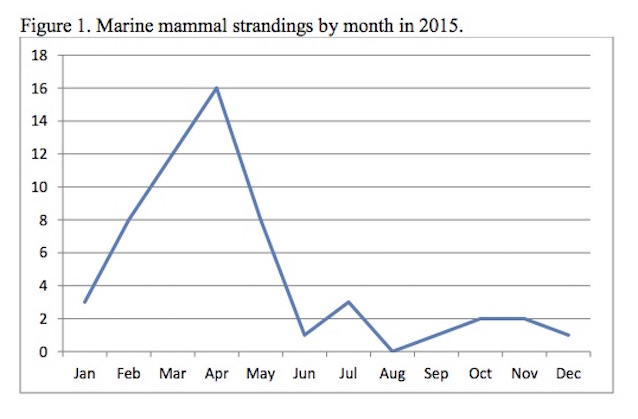
Given its size and characteristic protrusion near the Gulf Stream, Hatteras Island typically encounters the most marine mammal strandings (Figure 2). Both Bodie and Ocracoke Islands showed average stranding numbers and accounted for nearly one-quarter of this year’s animals.
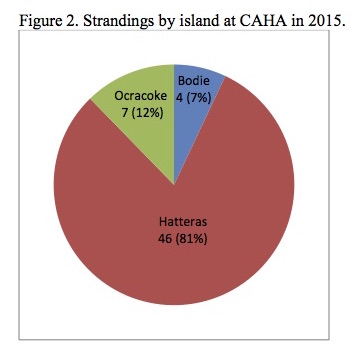
The condition in which an animal arrives on the beach determines the level of data collection and sampling that follows. Only 15% of stranded marine mammals experienced advanced/skeletal stages of decomposition in 2015 (Figure 3). This is fortunate in that more advanced sampling (histological, genetic, pathological, clinical, life history) was conducted with the remaining animals thereby giving further insight into potential cause of death or reason for stranding. Of the four animals (7%) that stranded alive, three were successfully euthanized while one case involved a neonatal bottlenose dolphin that died naturally on the beach upon arrival of staff. The neonate beached, then was pushed back out by the public, and re-stranded. The euthanized animals include two Dwarf sperm whales (Ks) and one Short-finned Pilot whale (Gm).
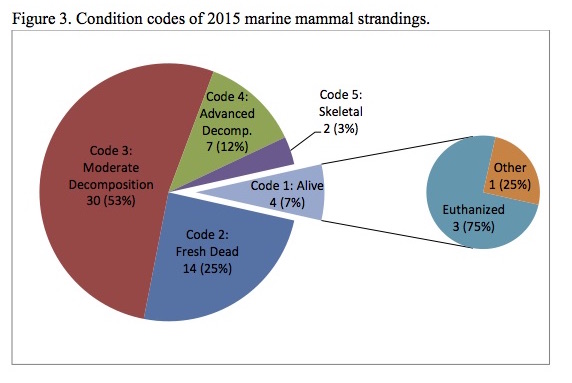
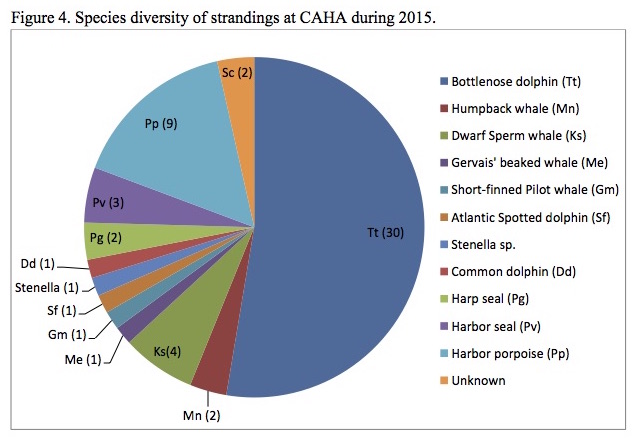
An assortment of marine mammals was observed during 2015, the 11 distinct species (Figure 4) is an average number for CAHA but has varied previously from 6-14 species. One yearly trend that remains unchanged is the abundant presence of stranded Bottlenose dolphins; over half of 2015 animals were Tt, which is within the normal range for CAHA. While NOAA has not officially declared an end to the dolphin morbillivirus event, it appears the presence of infected animals has ceased. Two pinneped species were documented as stranded in the winter/spring months; three Harbor seals and two Harp seals of various stages of decomposition from Code 2 to Code 4. Gray seals were documented in the area on numerous occasions (as the other two species), but all were alive individuals. Two large-whale cases, both Humpback whales, were documented; one on Pea Island NWR and one near Hatteras Inlet.
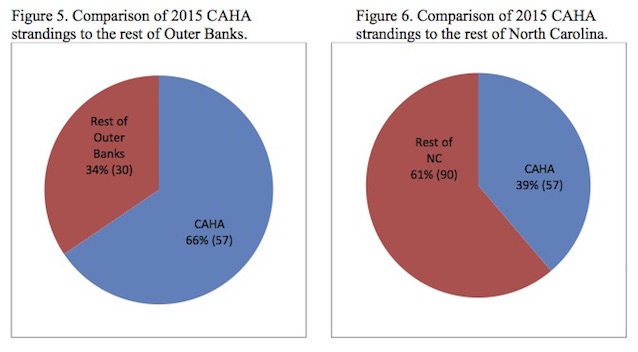
The marine mammal strandings documented by CAHA in 2015 encompassed the majority of total strandings documented on the outer banks as well as roughly one-third of total North Carolina strandings (Figure 5 and Figure 6). Human Interaction (HI) is one common element that is observed on a yearly basis among strandings, whether or not HI directly contributed to the animal stranding remains debatable. Examples of HI include entanglement (fishery), hooking, ingestion, vessel trauma, gunshot, harassment, or mutilation. Of the total 57 stranded animals in 2015, four of them (7%) showed signs of HI. This low park percentage is favorable but is not indicative of overall negative effects humans have had on marine mammals during 2015; these were merely documented cases. Three cases of HI involved bottlenose dolphins and one involved a harbor porpoise. The Pp (CAHA 301) had the skin/blubber layer cleanly cut off by an instrument on the left and right body while its dorsal fin was also cleanly severed (unable to determine whether lacerations occurred pre or post mortem). One Tt (CAHA 285) had fresh line impressions/wraps at the rostrum and mandible, line impressions at both pectoral flippers/dorsal fin, and three lacerations at peduncle (one nearly severs peduncle). Another Tt (CAHA 328) had its fluke severed at peduncle with an instrument, and multiple fresh line impressions at head which also correspond to impressions at the mandible. The final Tt (CAHA 329) also had its fluke severed at cranial peduncle with an instrument, as well as two distinct fresh line impressions at the head.
Unusual Mortality Event (UME)
As of the end of 2015, the Unusual Mortality Event associated with the morbillivirus strain has not been declared over by NOAA. If not completely ceased, the lab testing for this virus has been limited to very few individuals. The stranding numbers of Tt at CAHA has returned to normal levels (Figure 7) and dead individuals are not showing clinical signs of the virus externally or internally. At this time, the point at which this UME will be declared “ended” is unknown.
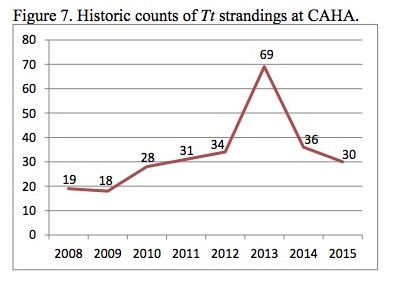
Live Seal Sightings
When ocean temperatures plummet during the winter and spring months, seal sightings are a common occurrence. Coming from the north, the seals migrate along the Outer Banks coast following the colder water while feeding. They will haul-out onto the beach to rest and this point they become a documentable occurrence. The seals are generally healthy and strict monitoring protocols are followed to safely observe the seal at a distance so as not to change its behavior. If an abnormality is observed (e.g. poor health, entanglement, broken appendage, open wounds), only then is intervention acceptable. If necessary, a capture and rehabilitation plan is devised and implemented by OBXMMSN members.
Seal activity occurred during the first four months of the year; three species of seals were documented on the shores of CAHA for a combined total of 67 separate sightings (Appendix A: Map 5-7). Generally, the most common seal observed at CAHA is the Harbor seal (Phoca vitulina); 43 individuals were observed. The Gray seals (Halichoerus grypus) are less common to this area yet six individuals were observed on multiple occasions; even two Harp seals (Pagophilus groenlandica) were observed in 2015 - this species tends to arrive on the outer banks during coldest sustained ocean temperatures. Only four unidentified seals were observed. A total of 5 sightings occurred on Bodie Island, 6 on Green Island, 51 on Hatteras Island, and 5 on Ocracoke; monthly, this can be summarized as 8 in January, 24 in February, 14 in March, and 21 in April. Historically, the south end of Green Island has been used by Harbor seals as a haul-out site for consecutive years, therefore a sighting doesn’t necessarily imply one individual; the most observed at one time in 2015 was 2 but up to 33 seals have previously been observed. Dredging and bridge-building equipment has been present at Oregon Inlet for multiple consecutive years, which is 0.4 miles from the Green Island haul-out site. The reduction in seal activity in/around Oregon Inlet may be attributed to the large equipment and noise within the 0.3-mile-wide inlet. In 2016, a new construction project will be initiated at Oregon Inlet to replace the existing bridge that connects Bodie to Hatteras Island; continuing anthropogenic noise for an indefinite period of time.
Atlantic Fleet Training and Testing (AFTT)
Many varieties of Military Training Exercises (MTE) occur on a yearly basis along the east coast from Virginia to Florida; some include sonar. There is experimental evidence suggesting that anthropogenic sonar disorients and causes harm to marine mammals. The OBXMMSN is notified prior to these exercises and given special instructions if unusual strandings should occur during the MTE. In the case of single stranded animals, NOAA personnel must be notified by text/email but an immediate pager is available in case of emergencies i.e. live strandings, large whale, beaked whale, and multiple (mass) strandings. Overall, CAHA documented three stranding events that occurred during AFTT events (Table 1), all of which were bottlenose dolphins.
Table 1. Actual AFTT Events and Corresponding Strandings in 2015.
|
|
2015 MTE Duration and Strandings |
|
|
MTE |
MTE 1 |
MTE 2 |
|
Duration |
1/8–2/6 |
9/3–10/2 |
|
# Strandings |
2 |
1 |
Historic Data
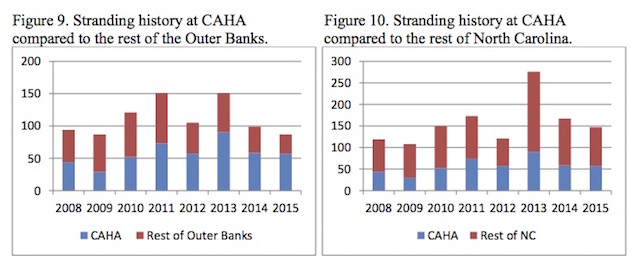
The observed data suggests that CAHA is a major contributor to the overall stranding numbers of the Outer Banks and the state of North Carolina (Figure 9 and Figure 10). Strandings at CAHA account for an average 58 individual animals per year from 2008-2015, while also averaging one-half of all strandings on the Outer Banks during this period and one-third of North Carolina’s total strandings.
In a 10-year period (Figure 11), it is probable that the trend of generally high stranding numbers will continue with time so long as the geographical characteristics of the seashore remain the same. The average number of strandings over this period is 54 animals per year. The apex of the graph represents the recent morbillivirus UME that claimed an unusually high number of Tt individuals.
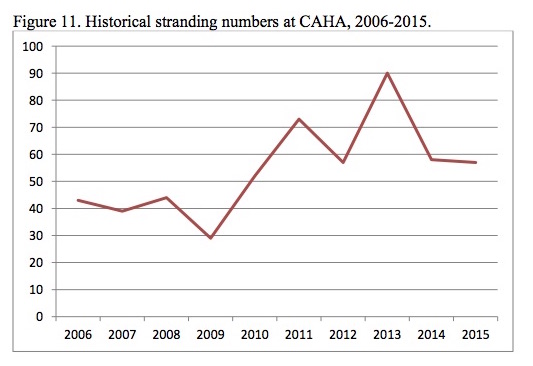
See the 2015 Marine Mammal Stranding Summary from Cape Hatteras Appendix A for maps of the different strandings.
Tags
Last updated: December 11, 2017
